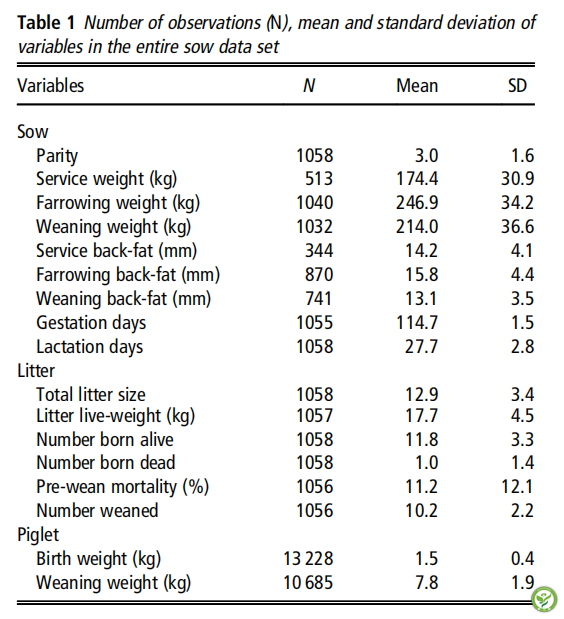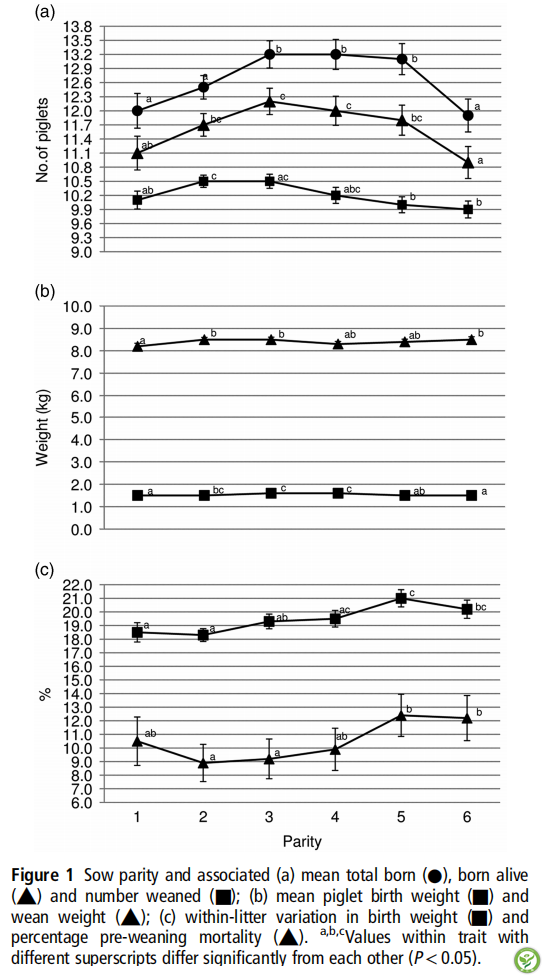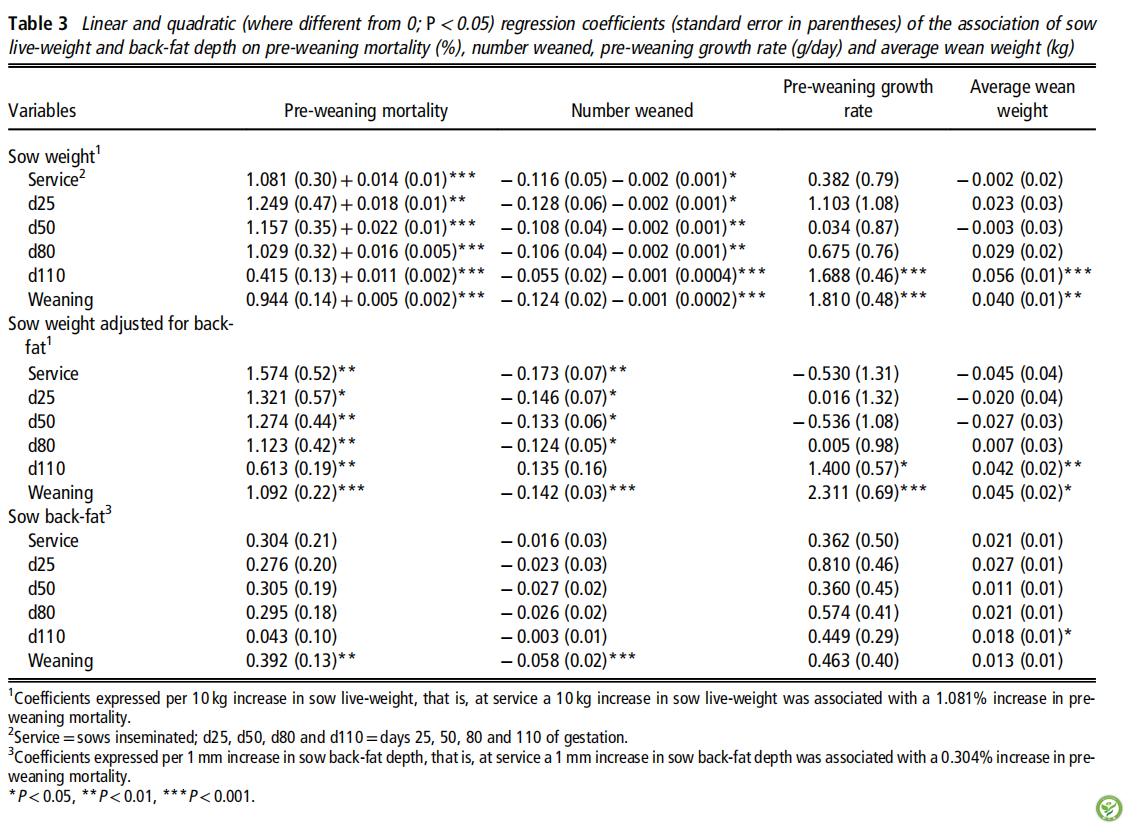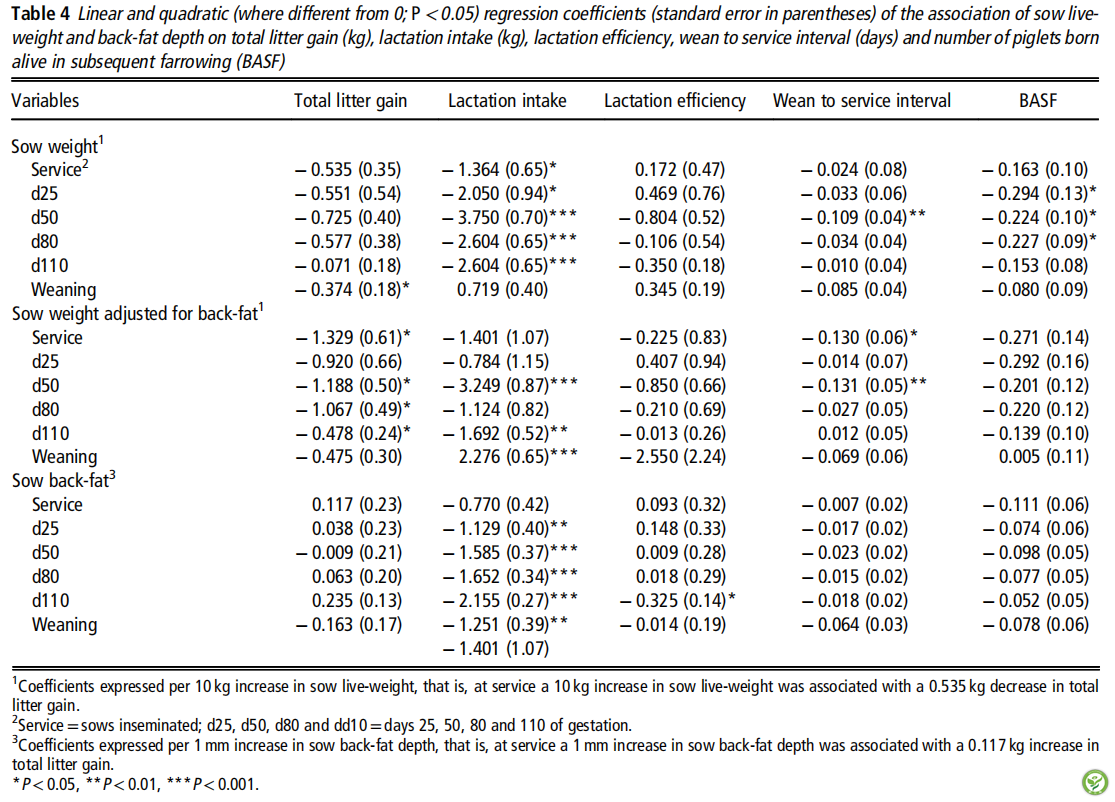原标题:母猪胎次、体重和背膘厚的关联分析作为评估母猪生产力的指标
An association analysis of sow parity, live-weight and back-fat depth as indicators of sow productivity
作者:A. Lavery1,2,3† , P. G. Lawlor1 , E. Magowan2 , H. M. Miller3
, K. O’Driscoll1 and D. P. Berry1
1Teagasc,Animal & Grassland Research and Innovation Centre,Moorepark,Fermoy,Co. CorkP61 C996,Ireland.
2Agri-Food and Bioscience Institute,Large Park,Hillsborough,Co. Down BT26 6DR,Northern Ireland.
3Faculty of Biological Sciences,University of Leeds,Leeds LS2 9JT,UK.
来源:Animal (2019), 13:3, pp 622–630;doi:10.1017/S1751731118001799
翻译:肠动力研究院 梁琦
【摘要】母猪妊娠期的体重和背膘厚度是确保母猪最佳生产力的关键点,明确这一条是至关重要的。本文旨在研究确认妊娠期母猪胎次、体重、背膘厚之间的关联性及与母猪后续胎次繁殖性能之间的关系。文章分析了2005-2015年在两个试验农场进行10次试验的1058头母猪和13827头仔猪的记录。母猪胎次(1-6)每个胎次的母猪数量分别为:232,277,180,131,132和106。分析的指标包括总产仔数(TB)、活仔数(BA)、仔猪出生重(BtWT)、断奶前死亡率(PWM)、仔猪断奶重(WnWT)、断奶仔猪数(Wn)、断奶到配种的时间间隔(WSI)、下一肽次分娩的活仔数和哺乳母猪采食量。计算的指标包括LtV(窝仔猪出生重的标准差除以仔猪平均出生重)、断奶前每窝仔猪的生长速率(PWG)、窝总增重(TLG)、泌乳效率和交叉寄养后饲养的窝仔数。使用线性混合模型分析数据并考虑记录之间的协方差。结果显示,与后备母猪和6胎母猪相比,第3和第4胎母猪的TB、BA和BtWT显著增大(P <0.05)。第2和第3胎母猪的断奶仔猪数要比胎次大的母猪更多(P <0.05)。与后备母猪所产的仔猪相比,这些仔猪(2和3胎)的BtWT显著更大(P <0.05)。与青年母猪相比,LtV和PWM在5胎母猪出生的幼仔中显著更高(P <0.01)。而在配种时、妊娠第25天和第50天母猪的体重和背膘厚与TB,BA,BtWT,LtV,PWG,WnWT或哺乳效率均不相关(P>0.05)。妊娠期母猪的体重越大将导致PWM的增加(P <0.01)和Wn、哺乳期采食量的减少(P<0.05)。妊娠后期母猪背膘越厚将导致BA越低(P<0.05),但BtWT越高(P<0.05),而整个妊娠期母猪背膘越厚将导致其泌乳期采食量的减少(P <0.01)。研究还发现,母猪背膘厚与LtV,PWG,TLG,WSI或下一次分娩时活仔数不相关(P> 0.05)。总之,本研究表明,母猪胎次、体重和背膘厚可作为评估繁殖性能的指标。此外,该研究还为未来开发基准工具提供了依据,从而更好的监测和提高现代母猪群的生产力。
【关键词】荟萃分析,猪,繁殖,身体状况,胎次
以下是相关图表
表1:整个母猪数据集中的观察数(N),变量的平均值和标准差

图1:母猪胎次和相关(a)平均总出生数(●),出生数(▲)和断奶数(■); (b)仔猪平均出生重(■)和断奶重(▲); (c)出生体重(■)的窝内变异和断奶前死亡率(▲)。 a,b,c具有不同上标的性状内的值有显著差异(P <0.05)。

图2:母猪胎次与相关的(a)断奶前仔猪增长速率(■);(b)总窝增量(■),哺乳期摄入量(▲)和哺乳效率(●);(c)断奶到配种的时间间隔(■)和随后分娩时出生的仔猪数量(▲)。 a,b,c,d具有不同上标值表示性状内的数值差异显著不同(P <0.05)。

表2:母猪体重和背膘厚与总出生数,活仔数,平均出生重(kg)和仔猪出生重CV(%)的线性和二次(不同于0; P <0.05)回归系数的关系(括号中的标准误)

表3:母猪体重和背膘厚与断奶前死亡率(%),断奶数,断奶前生长速率(
g/day)和仔猪平均断奶重(kg)的线性和二次(不同于0; P <0.05)回归系数的关系(括号中的标准误)

表4:母猪体重和背膘厚与总窝重(kg),泌乳期间采食量(kg),泌乳效率和断奶到配种的时间间隔(days)和后续分娩的仔猪出生数(BASF)的线性和二次(不同于0; P <0.05)回归系数的关系(括号中的标准误)

结论
总的来说,这项研究已经量化了母猪胎次,体重和背膘厚与现代母猪繁殖性能的关系。产仔数和活仔数的增加与妊娠后期母猪体重和背膘厚的增加有关。较重、较胖的母猪分娩所生的仔猪以及断奶仔猪相对较重,但由于母猪调动了体内储备以满足仔猪的需求,因此哺乳期的摄入量较少。因此在配种时或实际上在妊娠早期,母猪的体重和背膘厚似乎不是繁殖成功的关键,但在妊娠期和哺乳期可能很重要。我们无法确定妊娠期间母猪的最佳目标体重和背膘厚,或者对日粮构成或配制水平对繁殖成功的影响做出结论。因此,这些应成为未来研究荟萃分析的重点
ABSTRACT
Understanding how critical sow live-weight and back-fat depth during gestation are in ensuring optimum sow productivity is important. The objective of this study was to quantify the association between sow parity, live-weight and back-fat depth during gestation with subsequent sow reproductive performance. Records of 1058 sows and 13 827 piglets from 10 trials on two research farms between the years 2005 and 2015 were analysed. Sows ranged from parity 1 to 6 with the number of sows per parity distributed as follows: 232, 277, 180, 131, 132 and 106, respectively. Variables that were analysed included total born (TB), born alive (BA), piglet birth weight (BtWT), pre-weaning mortality (PWM), piglet wean weight (WnWT), number of piglets weaned (Wn), wean to service interval (WSI), piglets born alive in subsequent farrowing and sow lactation feed intake. Calculated variables included the within-litter CV in birth weight (LtV), pre-weaning growth rate per litter (PWG), total litter gain (TLG), lactation efficiency and litter size reared after cross-fostering. Data were analysed using linear mixed models accounting for covariance among records. Third and fourth parity sows had more (P < 0.05) TB, BA and heavier BtWT compared with gilts and parity 6 sow contemporaries. Parities 2 and 3 sows weaned more (P < 0.05) piglets than older sows. These piglets had heavier (P < 0.05) birth weights than those from gilt litters. LtV and PWM were greater (P < 0.01) in litters born to parity 5 sows than those born to younger sows. Sow live-weight and back-fat depth at service, days 25 and 50 of gestation were not associated with TB, BA, BtWT, LtV, PWG, WnWT or lactation efficiency (P > 0.05). Heavier sow live-weight throughout gestation was associated with an increase in PWM (P < 0.01) and reduced Wn and lactation feed intake (P < 0.05). Deeper back-fat in late gestation was associated with fewer (P < 0.05) BA but heavier (P < 0.05) BtWT, whereas deeper back-fadepth throughout gestation was associated with reduced (P < 0.01) lactation feed intake. Sow back-fat depth was not associated with LtV, PWG, TLG, WSI or piglets born alive in subsequent farrowing (P > 0.05). In conclusion, this study showed that sow parity, live-weight and back-fat depth can be used as indicators of reproductive performance. In addition, this study also provides validation for future development of a benchmarking tool to monitor and improve the productivity of modern sow herd.
Keywords: meta-analysis, pigs, reproduction, body condition, parity
Conclusion
Overall this study has quantifified the association of sow parity, live-weight and back-fat depth with the reproductive performance of modern sows. Increased litter size and numbers born alive was associated with greater sow live-weight and back-fat depth in late gestation. Heavier, fatter sows had heavier piglets at birth and also weaned heavier piglets, but did so with less lactation intake as sows mobilised body reserves to meet the demands of the litter. Thus, sow liveweight and back-fat depth at service, or indeed during early gestation, appear not to be critical to reproductive success, but may be important later on in gestation and during lactation. We were unable to determine optimal target sow liveweights and back-fat depths during gestation, or to make conclusions about the effect of diet composition or allocation level on reproductive success. Therefore, these should be the focus of future meta-analyses of experimental studies.
如您需原文,请联系本文作者和出版方,或请垂询肠动力研究院。本网站发布的所有资料将尽最大可能注明出处、作者及日期,如无意中侵犯了您的知识产权,请来信及时告知,我们将立即予以删除。
All information released by the WeChat Official Account will do its best to indicate the source, author and date. If we inadvertently infringe on your intellectual property, please inform us in time and we will delete it immediately.





